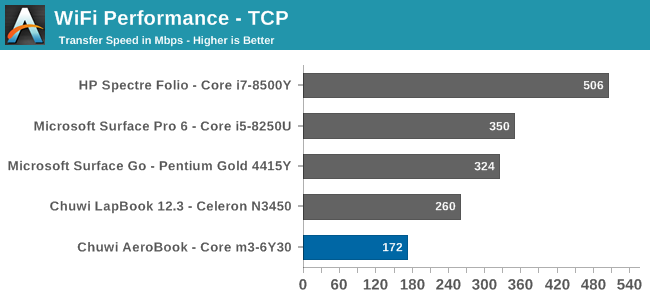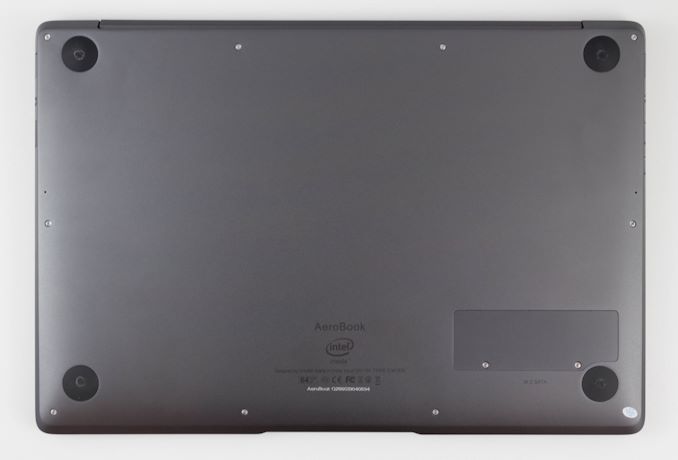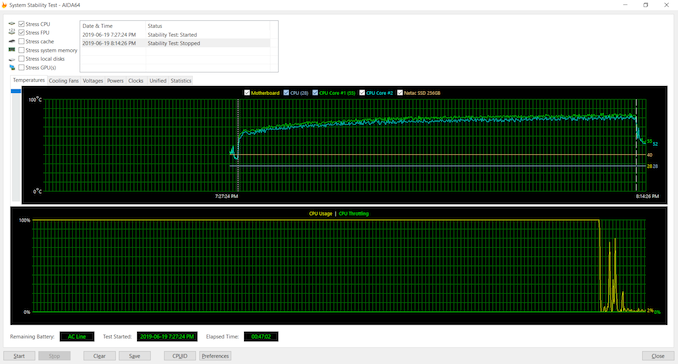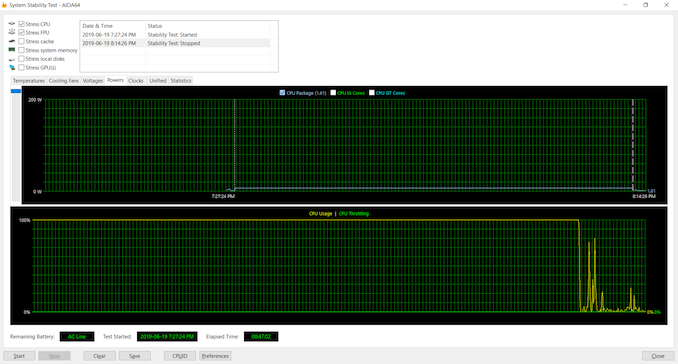The Chuwi AeroBook Review: One Small Step For Chuwi
by Brett Howse on June 21, 2019 8:00 AM ESTWireless
One area where Chuwi clearly focused on their price target was the wireless. We don’t often see a 1x1 solution anymore, but the AeroBook features just a single stream for Wi-Fi. Luckily that wireless card is an Intel Dual Band Wireless-AC 3165, and with Intel’s track record on network cards, at least some solace can be found in the connecting being rock solid.

As expected, the performance of just a single 5 GHz AC stream is much lower than what you’d get in any 2x2 wireless offering, which is the standard for most notebooks. But the connection was as solid as expected, with zero dropouts or reboots required to establish a Wi-Fi connection, which tends to be the case with Intel wireless adapters. The transfer rate is generally enough for most internet access, but if you want to copy files over the network, you’d likely be better off using USB.
Audio
The Chuwi AeroBook contains speakers. We could pretty much wrap it up there. Most notebooks don’t offer much in the way of dynamic range on their incredibly small speakers, but the AeroBook offers almost no bass at all. The speakers get reasonably loud, with around 80 dB(A) measured one inch over the trackpad, but there was little in the way of stereo separation and the speakers sound very poor. Luckily the 3.5 mm jack seemed to function well.
Thermals
One of the benefits of sticking with a low TDP processor is that Chuwi can continue to offer a completely fanless device. With only a 4.5-Watt TDP, the Core m3 is even a bit less TDP than a Gemini Lake Atom, which has a 6-Watt TDP, although the scenario design power is closer at 4.8 Watts.
To see how the AeroBook handles load, it was run at 100% CPU while monitoring the temperatures and power draw.
The AeroBook had no issues maintaining maximum performance. It quickly jumped to the 2.2 GHz maximum, drawing 7.56 Watts in the process, and then once its PL1 was exhausted it moved into a steady PL2 draw averaging about 6.8 Watts, and maintaining almost a 2.0 GHz frequency for the duration of the run.
The maximum CPU temperature was 85°C, but averaged closer to 75°C in steady state, and the notebook itself got warm on the bottom but never hot to the touch. Chuwi have had issues in the past with cooling, but it looks like they’ve got them sorted out on the AeroBook.
Software
Chuwi offers no additional software over the base install of Windows 10, which is something they’ve been consistent at, and a welcome change over many of the manufacturers who bundle in unwanted applications and bloat. That’s not to say that Windows 10 doesn’t offer bloat itself – because it does – but Chuwi at least isn’t adding on to that.
For some reason the company tends to put shortcuts on the desktop for This PC, Network, Control Panel, and your user profile, which gives the look a bit of an XP-era feel, and if a guess had to be made, it would be because XP was so popular in their native China. Luckily they can be deleted off the desktop if you like a clean desktop.













51 Comments
View All Comments
bubblyboo - Friday, June 21, 2019 - link
US-warranty vs no warranty is also pretty unfair.nandnandnand - Sunday, June 23, 2019 - link
Marlin and levizx are right. The sucker price is for suckers. There's something on sale in any given category at any moment. Go back a year or two and the main difference in a laptop will be the specific CPUs and GPUs, so judge price/perf accordingly.systemBuilder - Friday, July 19, 2019 - link
You can think of the "m" series of processors as "bringing the Atom Slowness to the Pentium Line of CPUs". In other words, when you spend 90% of your life thermally throttled because the device is stupid-thin AND stupid-light, you suffer a great deal... I prefer my Acer Chromebook c720 i3.Urthor - Saturday, June 22, 2019 - link
You have to understand the pressure that Intel puts on sellers with the prices of its CPUs to OEM'sSecondhand laptops have been FAR cheaper for a LOT longer because ultimately Intel's control of the key part stops them discounting.
mkozakewich - Friday, June 21, 2019 - link
Chuwi are a cheap manufacturer that have been known to ship cheap parts that fail, and they won't respond to warranty requests unless you can post a video to YouTube (seriously, what) showing some kind of physical damage.yeeeeman - Friday, June 21, 2019 - link
For 250$, maybe, but for 500...no wayabufrejoval - Friday, June 21, 2019 - link
I got the Lapbook 12.3 after the review here.The main attraction was the high-resolution (3k) screen and totally silent operation for e-books and surfing. And while my first unit had a defective space-bar and completely unusable touchpad (way too sensitive), the second one was rather better with both, and delivered on the performance and usability criteria.
I moved Windows 10 immediately to a 128GB M.2 SSD and then put a Ubuntu 18.04 on the eMMC, mostly because I needed a little more space anyway and to avoid slowing the machine via the storage.
The disappointment came when I unpacked the ChuWi in the hotel after a flight and found it all bent out of shape from a battery that had gassed out, because a replacement battery cannot be bought from anyone or anywhere: ChuWi simply does not sell spare parts.
It’s easy enough to replace, a couple of screws and unplugging a connector, but without a spare part, it’s life is essentially ended before a year is full.
After a bit of howling and screaming they did offer me to send it to HongKong for a free replacement, and I am torn between using it just on external power or actually see if it gets back fixed.
I’m not sure I can attribute the battery failure to a quality defect on their side, though.
It’s the second time the very same thing happened to me and the other one was a Gigabyte mobile workstation at 10x the price (no issue with the spare parts there).
I believe the fault actually lies with Windows.
When I hibernate a notebook, I expect it to stay powered off until I power it up again. But Windows these days has so much AI, it knows better and seems to wake up hibernated (not just suspended) machines for things like regular reports to Redmont.
Since some of my machines are configured to actually boot Ubuntu, CentOS or Fedora by default, that is especially useless, because the Windows induced wakeup has them boot an OS that didn’t even ask for that.
In the confines of rucksack in an overhead locker then, these machines can easily overheat and cook the batteries until they’re dead.
I have tried very hard to find a recipe to keep these wakeups from happening. I really do like the ability to keep documents and VMs open (and hibernated on SSD), while I travel.
So far the only way to avoid these wakeups, seems to be removing the power supply before hibernating the machines: At that point “hibernate” seems to be actually understood by Microsoft as meaning “don’t wake automagically so you don’t fry batteries by accident in an airplane”.
I have started using that approach on commutes, but for longer trips, I do shut down those laptops, because the risk of unwarranted wakeups is too high.
So there you have it: ChuWis don’t disappoint as hardware per se, but spare parts or service are not included at this price.
olafgarten - Friday, June 21, 2019 - link
Windows doesn't wake hibernated laptops unless some hardware connected to it issues a wakeup signal. You either accidentally hit the on button or you have a faulty keyboard wakeup key.Also if you are using Ubuntu as the main OS, you are probably booting into Grub and so Windows has no control over the wakeup.
abufrejoval - Friday, June 21, 2019 - link
And so would I have sworn, perhaps not on my life, but at least a case of beer...I was far more inclined to blame the flying or even the security scanners at the airport.
Yet major problems there would be hard to hide...
And then I got a Lenovo S730 ultrabook to replace it and observed it for days.
Hibernated it (hybrid disabled) and was very surprised to watch it power up and boot whatever happend to be configured as primary in the BIOS, ... and that changed between Windows 10 1903 and Fedora 30, depending on what was more frequently used.
Mind you, I disconnected all external devices, nothing and nobody touching it, the power button requires quite a bit of force to exercise, but within half an hour to a full one it would power on again.
Now, I am pretty sure, that nobody in my network sends magic packets or patterns, and in any case I disabled that too, but no change. There are dozens of jobs scheduled in Windows and I deleted quite a few of those, mostly the "calling home" type. Also stopped and disabled the "user experience service" etc.
But so far the only thing that changed the behavior was to change the unplugging and the hibernate sequence: With the power plugged in at hibernate, Windows seems to assume it's ok to run scheduled jobs. Without external power, "hibernate" is "hibernate".
And these days, when you say "shut down" on Windows, you have to uncheck a hidden option in Windows to actually *make* it shut-down. Otherwise it will be 'smart' enough to assume that restarting Windows more quickly is more important and interpret "shutdown" as suspend-with-fast-restart...
And I have seen similar behavior in desktops that were *suspended* to RAM, with all magic packets and PS/2 as well as USB events disabled in BIOS to cause power up.
On those systems, massive amounts of RAM and SATA SSDs made hibernation less attractive and standby seemed a good compromise...
Here on the Lenovo RAM is stuck as 16GB and the NVMe will restore RAM at 3GB/s...
But "wakeup2die" isn't really attractive.
Perhaps we could get a little more end-user data on this?
Mil0 - Sunday, June 23, 2019 - link
I've seen this behavior as well, using MSI/Acer laptops, so it's not limited to some manufacturers.Thanks for the no-power-when-hibernating trick, I'll use that from now on.
It's a bit silly that there is no thermal protection on the battery - should be a pretty easy/cheap fix.